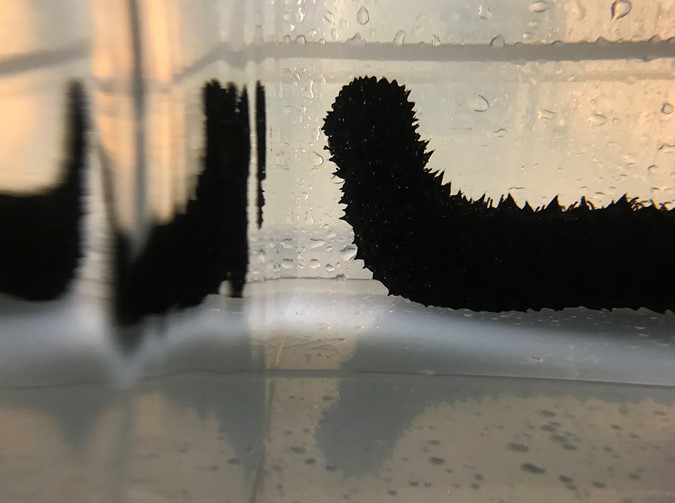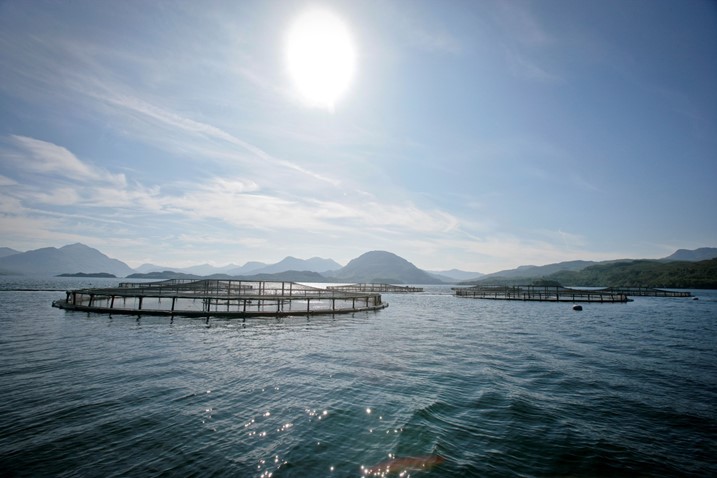Investigating sea cucumbers as bioremediators for salmon farms
This project aims to bridge the gap between fish production and environmental conservation by bringing bioremediation to marine aquaculture.
Project Summary
Project life: three months (feasibility study); 18 months (full R&D)
Anticipated Benefits
This project investigates the potential of Scottish sea cucumbers to reduce the build-up of salmon waste in the environment. Laboratory experiments were used to determine the capacity of Scottish sea cucumbers to efficiently recycle salmon aquaculture waste. A computer tool is also being developed to simulate the interactions between environmental conditions and sea cucumber physiology. By adopting bioremediation, farmers could significantly increase production without consequences for the seabed, leading to an improved situation for both food producers and the environment.
£138,658
Total value
Partners
FEASIBILITY STUDY - total value £56,449
- Academic Partner: Scottish Association for Marine Science (SAMS), a partner of UHI
- Lead Commercial Partner: Blue Remediation Ltd
- Commercial Partner: Mowi
- Funders: Seafood Innovation Fund (SIF) £46,449; SAIC £5,000
FULL R&D PROJECT - total value £244,171
- Academic and commercial partners: as above
- Funders: UK Seafood Innovation Fund (SIF)* £199,985; SAIC £10,000
* The UK Seafood Innovation Fund supports new ideas to deliver cutting-edge technology and innovation to the UK’s fishing, aquaculture and seafood industries.
Administered by the Centre for Environment, Fisheries and Aquaculture Science (Cefas) on behalf of the Department for Environment, Food and Rural Affairs (Defra), the programme encourages sustainable and innovative ideas to bring about seafood security, new partnerships across seafood and technology sectors, and to contribute to strong evidence-based management.
Case study
Download PDF
Managing and minimising the environmental impact of aquaculture is crucial for supporting the sector’s growth. Alongside the extensive regulatory frameworks that are in place, we have identified a possible natural solution that could absorb some of the waste that is inevitably produced by fish and the process of feeding them.
Soizic Garnier, Blue Remediation co-founder
Background

Blue Remediation’s project aims to bridge the gap between fish production and environmental conservation by bringing bioremediation to marine aquaculture.
Bioremediation is a natural solution where living organisms mitigate waste accumulation. This innovation aims to investigate and quantify the mitigation potential of Scottish sea cucumbers to reduce salmon waste accumulation in the environment through (1) laboratory experiments and (2) designing a computer model. The laboratory experiments aimed to determine the capacity of Scottish sea cucumbers to (i) feed off salmon faeces, and (ii) efficiently recycle salmon aquaculture waste, while the computer tool simulated the interactions between environmental conditions and sea cucumber physiology.
The final goal is to have a computer model approved by the government and thereby offer farmers a sustainable alternative to reduce their seabed impact, the factor currently limiting their fish production. By adopting bioremediation, farms’ finfish production could significantly increase (by >20%) without consequences for the seabed, leading to an improved situation for both industries and the environment.
Blue Remediation, together with the project partners the Scottish Association for Marine Science (SAMS) and Mowi Scotland, ran a three-month feasibility study for the period 24/11/2020 - 28/02/2021, with funding secured from the UK Seafood Innovation Fund (SIF) and Sustainable Aquaculture Innovation Centre (SAIC).
The UK Seafood Innovation Fund supports new ideas to deliver cutting-edge technology and innovation to the UK’s fishing, aquaculture and seafood industries. Administered by the Centre for Environment, Fisheries and Aquaculture Science (Cefas) on behalf of the Department for Environment, Food and Rural Affairs (Defra), the programme encourages sustainable and innovative ideas to bring about seafood security, new partnerships across seafood and technology sectors, and to contribute to strong evidence-based management.

Feasibility study: key objectives
WP1: Lab Experiment
The lab experiment aimed to evaluate the physiological responses of the Scottish sea cucumber (Holothuria forskali), such as ingestion rate, growth, etc. when fed on salmon waste. The three-month experiment was performed at SAMS facilities in Oban, using 18 sea cucumbers fed on different diets, including ‘waste’ comprising salmon farm sediment, uneaten feed and faeces waste versus ‘sea mud’ as a control. The fully crossed experimental design included tanks with and without sea cucumbers as positive and negative controls. This set-up simulates realistic feeding conditions that sea cucumbers will face when remediating the seabed under salmon farms.
WP2: Numerical Representation of the Sea Cucumber
In order to predict the amount of sea cucumbers needed to process the farm waste discharge and to quantify the decrease in benthic pollution in the long-term and on an industrial scale, the study is planning to model the physiology of the sea cucumber (i.e. their ingestion rate and the conversion of the energy assimilated into growth, respiration and excretion) through a computer model. The results from the lab experiments will be implemented in the model to assess those processes and determinate the oxygen consumption, ammonia excretion and removal of Particulate Organic Matter (POM) from the seabed caused by the sea cucumbers. A quantification of these variables will provide important criteria to estimate the health of the benthos.

Blue Remediation’s concept has been proven during the three-month feasibility study. The Scottish sea cucumber Holothuria forskali survived feeding on a mixture composed of salmon waste (salmon faeces + uneaten feed) and sea mud during the 58-day laboratory experiment. In addition, preliminary results indicated that sea cucumbers may remove up to 70% of waste in targeted areas below aquaculture pens. This highlights the potential of sea cucumbers to clean the seabed and consequently improve the current anoxic status of the benthos below salmon farms.
Impact and summary of findings to date
Full R&D project: 18 months (September 2021 to March 2023)
Aimed at building on the results of the feasibility study, the R&D project aims to develop a prototype to demonstrate the bioremediation concept in an industrial setting. The objectives are: (i) improve the numerical model developed during the feasibility study via additional lab experiments, (ii) validate the numerical results with real data through an in-situ trial, and (iii) combine the physiological model with NewDepomod (the physical model currently used to assess the fish biomass to respect the legislation) to make predictions at an industrial scale.
The full R&D project is based on three work packages:
WP1: Additional laboratory experiments to further understand the physiology of the sea cucumber H. forskali
The feasibility study demonstrated the potential of H. forskali to reduce salmon waste and the need for investigating the seasonality and body size effect on their ingestion rate to have more representative long-term predictions. Therefore, the project will investigate how the physiological parameters vary with body size and temperature.
WP2: In-situ trial to test the sea cucumber bioremediation concept in real condition
The work package aims to:
- develop a first prototype of the bioremediation concept using sea cucumbers on a salmon farm scale
- collect in-situ data to validate the numerical model (i.e. to ensure that the results provided by our equations are representative of what is happening in the field)
- explore how sea cucumbers affect the ecology of the sediment infaunal community
WP3: Combine the validated ecological model with the physical model NewDepomod
To finalise the product, the bioremediation effect of sea cucumber aims to be coupled to the NewDepomod software through four steps: Model v1 - Calibrating the physiological model using experimental and in-situ data, Model v2 - Adding the spatial dimension, Model v3 - Coupling a sea cucumber module to the NewDepomod model.

Using sea cucumbers could transform the sector’s approach to waste management. Integrated multi-trophic aquaculture is still in its infancy in Scotland, but could be a valuable, sustainable, circular method of ensuring resources don’t go to waste.
Heather Jones, SAIC CEO